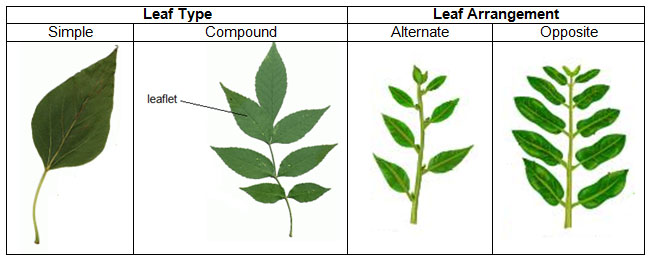
In this section, you are going to use a dichotomous key to identify leaves of trees commons in Texas. Before you begin, study the following diagrams to familiarize yourself with some of the terms used to identify leaves.

![]() Use the dichotomous key and the leaves pictured to identify some of the trees common in Texas. Click on each image to see a more detailed picture.
Use the dichotomous key and the leaves pictured to identify some of the trees common in Texas. Click on each image to see a more detailed picture.
Follow these guidelines when using a dichotomous key.
| 1. | a. Leaves are needle-like. | Go to #2 |
| b. Leaves are not needle-like. | Go to #9 | |
| 2. | a. Leaves are attached singly. | Douglas Fir |
| b. Leaves are attached in bundles. | Go to #3 | |
| 3. | a. Needles are in bundles of two. | Go to #4 |
| b. Needles are in bundles of three. | Go to #7 | |
| 4. | a. Needles are one to two inches long. | Pinyon Pine |
| b. Needles are longer than two inches. | Go to #5 | |
| 5. | a. Needles are three to five inches long. | Shortleaf Pine |
| b. Needles are five inches or longer. | Go to #6 | |
| 6. | a. Needles are light green and dull in color. | Italian Stone Pine |
| b. Needles are dark green and glossy in color. | Slash Pine | |
| 7. | a. Needles are less than five inches long. | Mexican Pinyon Pine |
| b. Needles are longer than five inches. | Go to #8 | |
| 8. | a. Needles are five to ten inches long. | Loblolly Pine |
| b. Needles are ten to eighteen inches long. | Longleaf Pine | |
| 9. | a. Leaves are compound. | Go to #10 |
| b. Leaves are simple. | Go to #17 | |
| 10. | a. Leaves are oppositely attached. | Go to #11 |
| b. Leaves are alternately attached. | Go to #15 | |
| 11. | a. Leaflets are arranged palmately (like a hand). | Go to #12 |
| b. Leaflets are arranged pinnately (like a feather). | Go to #13 | |
| 12. | a. Leaflets are small; one to three inches long. | Lilac Chastetree |
| b. Leaflets are large; three to six inches long | Red Buckeye | |
| 13. | a. There are three leaflets. | Boxelder |
| b. There are five or seven leaflets. | Go to #14 | |
| 14. | a. Leaflets are oval or round and .25-2.5 inches long. | Texas Ash |
| b. Leaflets are not oval or round; leaflets are elongated with tapered ends and are three to four inches long. | Mexican Ash | |
| 15. | a. Leaves have an even number of leaflets. | Chinese Pistache |
| b. Leaves have five to nine leaflets. | Go to #16 | |
| 16. | a. Leaflets are toothed and all about the same size. | Mexican-Buckeye |
| b. Terminal (end) leaflet is larger than the others. | Hickory | |
| 17. | a. Leaves are attached oppositely to twig. | Go to #18 |
| b. Leaves are attached alternately to twig. | Go to #21 | |
| 18. | a. Leaves are heart-shaped. | Southern Catalpa |
| b. Leaves are not heart-shaped. | Go to #19 | |
| 19. | a. Leaves are lobed. | Maple |
| b. Leaves are oval, round, or elliptical. | Go to #20 | |
| 20. | a. Leaf edge is smooth. | Flowering Dogwood |
| b. Leaf edge is not smooth. | Rusty Blackhaw | |
| 21. | a. Leaves are star-shaped. | Sweetgum |
| b. Leaves are not star-shaped. | Go to #22 | |
| 22. | a. Leaves are heart-shaped. | Redbud |
| b. Leaves are oval-shaped. | Hackberry |
Use the key to list the characteristic of the red buckeye in your notes.

Use the key to list the characteristic of the southern catalpa in your notes.

Sources for images used in the interactive, as they appear, top to bottom: